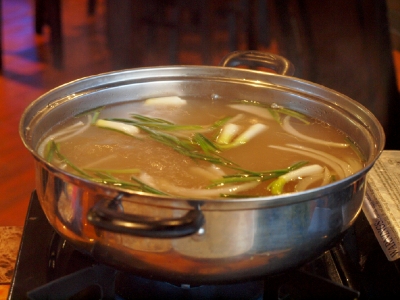[dropcap1]Q. [/dropcap1]What's the difference between a stock and a broth? Seems to me that they're the same.
[dropcap1]A. [/dropcap1]Funny you should ask. I don't know why, but about every sixty days, this matter comes up either in this department or on the radio show. You are making the bimonthly delivery this bimonth.
A stock is made by simmering meat, seafood or a vegetables in a pot of water. Often scraps are used for this--bones, seafood shells, leaves from a bunch of celery, etc. Also in the pot are flavoring herbs and spices (onions, celery, bay leaves, peppercorns). When the stock has cooked for the prescribed time (red meat bones take longer than shrimp shells), the solids are strained out. The finished stock is an ingredient for a wide range of recipes, with soups and sauces being the most common ones. It is not something you'd normally eat by itself.
[caption id="attachment_20926" align="alignnone" width="400"] Broth.[/caption]
A broth starts with a stock, but adds other ingredients--notably salt, but also vegetables, pasta, or small pieces of meat or seafood. It's usually clear to translucent, sometimes lightly colored. It's not usually thickened. A broth can be eaten as is. The king of the broths is consommé, which classically has no solids visible. And you would be able to see them if they were there, because a well-made consommé is clear, despite its deep flavor.
Soup, to carry this a bit further, is a broad category that ranges from the lightest (a broth) to the heaviest (gumbo and its ilk). It starts with a stock or a broth and goes from there.
Broth.[/caption]
A broth starts with a stock, but adds other ingredients--notably salt, but also vegetables, pasta, or small pieces of meat or seafood. It's usually clear to translucent, sometimes lightly colored. It's not usually thickened. A broth can be eaten as is. The king of the broths is consommé, which classically has no solids visible. And you would be able to see them if they were there, because a well-made consommé is clear, despite its deep flavor.
Soup, to carry this a bit further, is a broad category that ranges from the lightest (a broth) to the heaviest (gumbo and its ilk). It starts with a stock or a broth and goes from there.
Written by Tom Fitzmorris July 08, 2014 10:01 in